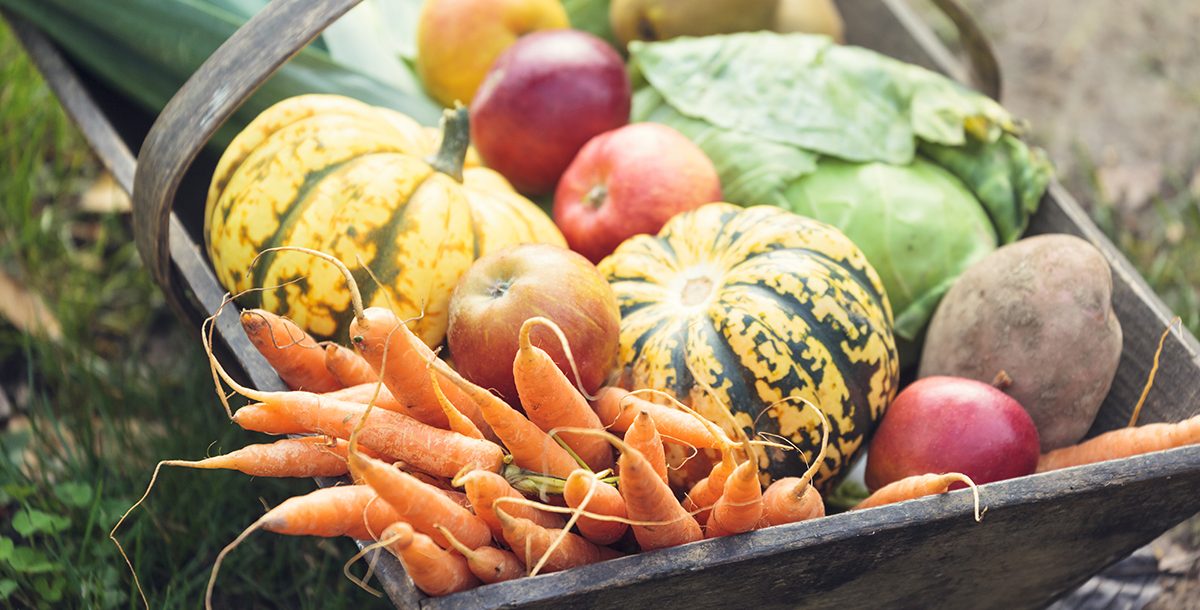Fall fruits and vegetables can be a great addition to a healthy diet!
Veggies and fruits provide vital nutrients that can help lower your risk of certain diseases while also supporting your body’s systems. And with autumn currently in full swing, it’s a great time to start looking into what food is fresh and in season.
While pumpkin may be the king of fall, remember there are many other fall fruits and vegetables to try.
Top autumn fruits and vegetables by month
The dividing line between summer crops and seasonal fall fruits and vegetables is thin. At the beginning of the season, you can still enjoy the final summer crops, like tomatoes, corn and cucumbers.
As the season goes on and the air feels cooler, the options change. However, you’ll still find a bounty of tasty produce at its peak, as you can see:
September: Apples, beans, beets, blackberries, blueberries, broccoli, cabbage, cantaloupe, carrots, cauliflower, collards, eggplant, grapes, kale, leeks, lettuce, mustard greens, onion, parsnips, peppers, potatoes, pumpkins, radishes, raspberries, spinach, summer squash, turnips, watermelon and winter squash.
October: Apples, beans, broccoli, cabbage, cantaloupe, carrots, cauliflower, collards, cucumbers, eggplant, grapes, kale, leeks, lettuce, mustard greens, onions, parsnips, peppers, potatoes, pumpkins, radishes, raspberries, summer squash, turnip greens, watermelon and winter squash.
November: Cabbage, cauliflower, leeks, parsnips, potatoes, pumpkins, radishes, turnips and winter squash.
When you know what’s in season, you know what to look for when shopping at the store and what to expect at the farmer’s market or roadside stands. And, of course, you may even try growing some of these seasonal fruits and veggies in your backyard garden.
Additionally, take a closer look at how the nutritional value of some of the above fall fruits and vegetables compare:
- Beets: This brightly colored root vegetable includes nitrates, folate, manganese and fiber in each serving, which can help lower blood pressure and open blood vessels.
- Broccoli: In a one-cup serving of broccoli, you get 90 percent of the daily recommended value of vitamin C and 77 percent of the DV of vitamin K, as well as folate, manganese, potassium and antioxidants.
- Carrots: A cup of carrots exceeds the daily recommended value of vitamin A, and it also gives you beta carotene, potassium as well as vitamins C and K.
- Cauliflower: A single cup of this versatile vegetable gives you antioxidants, vitamins C and K, folate and fiber, as well as three grams of protein.
- Collard greens: In one cup of collard greens, you consume one-quarter of your daily recommended value for calcium, four grams of protein as well as antioxidants.
- Kale: Adding a cup of kale to your salad gives you vitamins A, B, C and K, along with potassium, copper and calcium.
- Parsnips: In a one-cup serving of raw parsnips, you consume about half of the daily recommended value of vitamin C in addition to fiber, iron, magnesium and potassium.
- Pumpkin: A cup of pumpkin provides double the daily recommended value of vitamin A, as well as vitamin K, copper and fiber.
- Turnips: A serving of turnips contains one-fifth of the daily recommended value of vitamin C, as well as calcium, magnesium, potassium and vitamin B6.
Interested in talking with a health care provider about your nutrition goals? Find a Bon Secours primary care provider near you.





